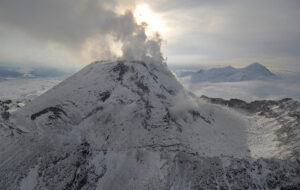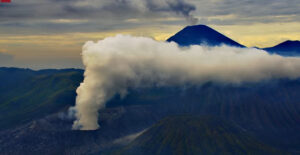For generations, the view from Japan’s Ioto (or Iwo Jima) island remained placid. The Pacific Ocean stretched to the horizon in all directions, broken only by a distant crag or two.
Suddenly, that all changed.
Lava and solidified volcanic rock gushed upward in an undersea volcanic eruption less than a kilometer from the tiny island’s coast in late October. As steam poured off the surface of the Pacific Ocean, a new island formed.
The eruption began on Oct. 21. Submerged beneath shallow waters, the unnamed volcano soon deposited ash and volcanic debris above the lapping waves.
The island remains unnamed, too — most reports estimate it at about 100 meters wide and 20 meters tall as of this writing. It’s a tiny outcrop, forged via the same volcanic mechanisms that have created many like it.
It’s anybody’s guess whether it establishes itself with any permanence. Volcanologists themselves can’t yet agree on its future.
Setsuya Nakada, a volcanologist at the University of Tokyo, explained to The Japan Times that because both liquid and solid materials comprise the accumulation, it could show staying power.
““The areas that don’t have lava could be scraped away. So if more and more lava comes out and covers the area, I think that part will remain forever,” Nakada said.
Yuji Usui, an analyst in the Japan Meteorological Agency’s volcanic division, wasn’t so sure. He told The Independent that even though volcanic activity near Ioto is common, this marks a significant event. But he’s not confident in the newborn island’s future.
Calling it “crumbly,” he said, “We just have to see the development. But the island may not last very long.”
Publicized as it is, the event doesn’t mark extremely rare circumstances. So-called “submarine” volcanoes could be twice as numerous as volcanoes on land. And some can erupt for years on end. A prolonged 2013 eruption at Nishinoshima, a few hundred kilometers north of Ioto, created an island that kept growing for 10 years.
Even eruptions that form major land masses can be unobtrusive until they break the surface. The volcanic eruptions that formed Hawaii would have remained invisible underwater “even if we’d been sitting above them in a Polynesian canoe,” one geologist told the New York Times.
A recent survey indicated that islands surface prolifically off Japan. The nation, located along the Pacific Ocean fault line known as the Ring of Fire, performed a recount of its known islands in 2023. The survey only counted land masses 100 meters across and larger.
Officials found 14,152 of them — over 7,000 more than previously thought.






